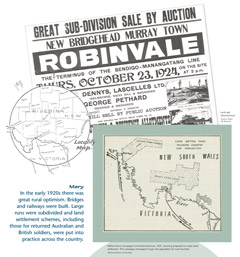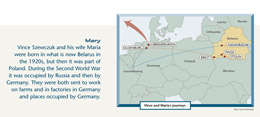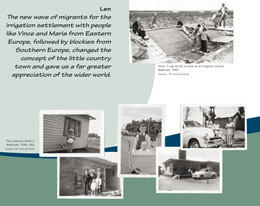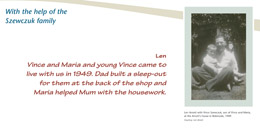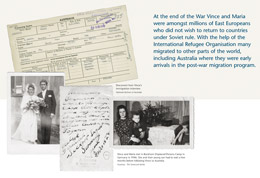| Robinvale perspectives |
Len Arnott and the Swezczuk family: a forerunner’s perspective
![]()
From township to irrigation settlement 1924-1949
Len Arnott’s migration story is a double one. It encompasses both his own family’s experience as newcomers to Robinvale, when it was first established in the 1920s, and the experience of a new wave of people who arrived with the construction of the irrigation settlement in the late 1940s. In their position as established locals, the Arnott’s welcomed and provided accommodation for the Szewczuk family.
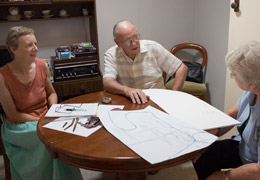 Len speaking with Mary and Kay Grose. Len speaking with Mary and Kay Grose. Photograph: Jo Sheldrick, 2006. |
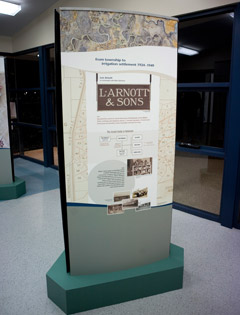 |
|
| View of Len Arnott’s story on display at Robinvale. Photograph: Jo Sheldrick, 2007. |
Mapping the personal, the local and historical
In the exhibition, maps, images and text were used to locate both the Arnott and Szewczuk migrations in historical context. The move to populate and develop rural Australia offered Len’s father, a returned Australian soldier from the First World War, new opportunities.
| Detail from Len Arnott, panel two, Migration Memories: Robinvale. Design: Paula McKindlay. |
Vince and Maria Szewczuk came to Australia as refugees from Poland after the Second World War. Vince was one of a number of displaced persons who were sent to work on the construction of the Robinvale irrigation settlement as part of their work contract with the Australian government.
Detail from Len Arnott panel three, Migration Memories: Robinvale. Design: Paula McKindlay. |
Through Len, Mary made contact with the Szewczuk family. They provided photographs, taped recordings and memories that filled out their family experience from a personal point of view.
The local
The intention for the new town of Robinvale in the 1920s, when Len’s parents set up their drapery business, was that it would become the centre of an irrigation settlement. But this didn’t happen until after the Second World War. The Arnott and Szewczuk family photographs show these different stages of development.
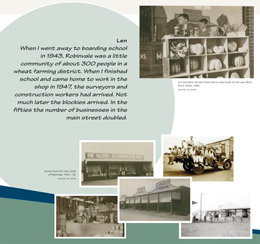 |
||
| Details from Len Arnott, panels one and three, Migration Memories: Robinvale. Design: Paula McKindlay. | ||
The personal in historical context
Len’s parents had been newcomers to Robinvale a generation before Vince and Maria Szewczuk arrived. They didn’t have language and cultural barriers to manage, and they were still in their country of birth, but like Vince and Maria they were starting again.
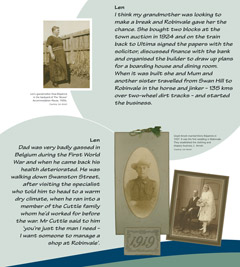 |
| Detail from Len Arnott, panel two, Migration Memories: Robinvale. Design: Paula McKindlay. |
|
Details from Len Arnott, panel three, Migration Memories: Robinvale. Design: Paula McKindlay |
Looking back on the project
Len
The older I get, the more interested in the history of the area and the family I’ve become, so I’m just reiterating to a degree what I’ve been researching for the last couple of years… Because of the limitations of time and space we’ve had to précis it down and in one way, from my point of view, I’ve left a lot of questions unanswered... Looking back I think of my own family's migration history. On Dad’s side my great grandfather came out from Scotland to Victoria and on my mother’s side my great great grandfather ended up in Australia after he stole a ham in London... The Szewczuks came to Robinvale with 180 displaced persons and were one of the very few married couples. They were housed in a hut complex which was not ideal for a family with a young child. My parents met and liked Vince and Maria so they built a room at the back of the shop for them. Maria did some housework in return for free board and accommodation. They virtually became members of the family.
 |
|
| Len Arnott. Photograph: Jo Sheldrick, 2007. |
Mary
As a keen member of the local historical society Len knew the detail of Robinvale’s local history, and his own family history, inside and out. He also had a great love of discussion and the different perspectives on history that different people offer. When I asked him about my use of text as authored by myself and others, he indicated that he would have been disappointed if the text was anonymous, ‘no doubt I’m going to say to Tory Pisasale, I was interested in that comment you made – it’ll open up discussion further’.

